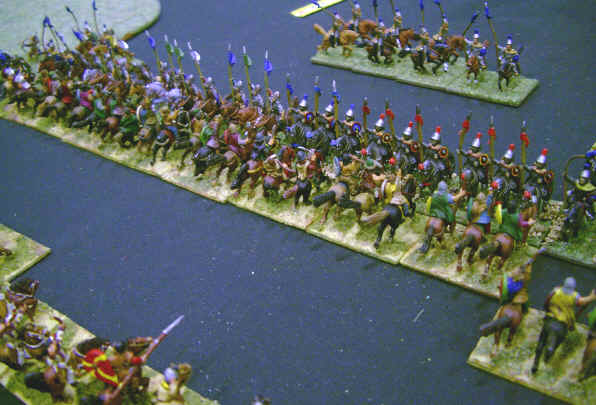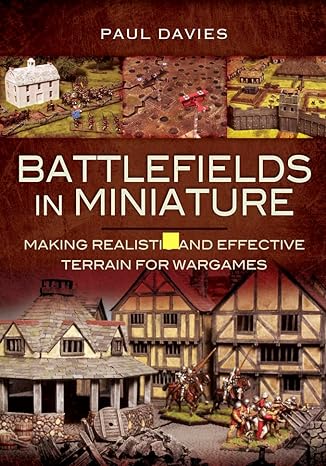BHGS Challenge 2005
a brief report and list of lists...
My Central London Nutter Patsy army turned out after only one practice game (which for a 2 list competition is a bit too few perhaps...?). The lists were this and that
Game 1 saw me play a Chinese Early Tang army, and selected that list as I fancied attacking Bw (X). The Tang initiated and lost out in a Lh lottery on its right against my mounted wing, and then the cavalry lost out to the supported auxilia in the center just before the warband managed to close on the Bw(X) 10-0. Good start!
Semi-interestingly I was recording pips to allow me to keep track of bounds in case of blitz (its the only way I've found to make sure I record bounds as I forget if its just marking down a 5-bar-gate tally) and this was how the game looked - lots more pips for the Tang, but a very simple Roman plan (attack anything in front of you) made possible by good matchups at deployment.
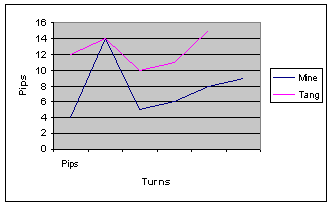
Next game I play Greg Mann's Hindu Indians. With lots of Bd (F) and elephants I again choose that list, and we had a desperate struggle which I finally won 9-1, largely because I attacked with and this gave me the matchup advantage at combat, and my pips were better. Also my artillery played a minor role - targeting his general at deployment caused the central command to lose control of a Bd (F) in turn 1, leaving a hole in the line which the Indians were never quite able to fill.
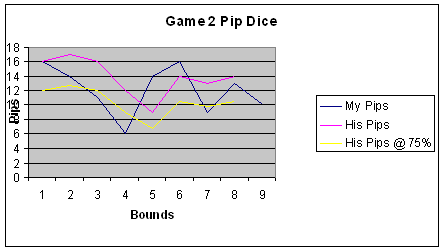
The chart shows a decisive "Pip Swing" my way in bounds 5 and 6, when the armies really started to get to grips with each other, allowing me to micromanage the matchups in my favour. Total pip scores over the first 8 bounds (I won in my bound 9) were 99 for me, 111 for Greg, however adjusting the Indian total down by 25% to allow for the extra command gives me a 99/83 advantage.
Next game I also used that list and then lost a close 0-10 to Mr Briggs LPIA (although I had all 4 of his commands within 1.5EE of breaking...doh, smacks of incompetence !). In this game I attempted to dash the Kn (F) command to inevitable but gradual destruction on my right, to buy time for the warband and auxilia to press home a hopefully decisive advantage in the middle and on the right.
h h
h
This was not to be, as the Statto-like Pip Analysis shows - the Arabs consistently outscored the Romans in almost every turn, allowing them to deal with the threats and press attacks themselves at will, redeploying almost the entire camel force across the width of the table to fight my 4 knights and overwhelm the accompanying Lh, and then pressing onto the baggage whilst their center managed to fight off envelopment by a mass of impetuous warband.
Pip totals were 125 for the Romans (over 11 bounds) vs 164 for the Arabs, (or an adjusted total of 123).
Game 4 was a hideous nightmare - my first defenders game, and again vs the Hindu Indians. With the list that had previously been successful I set up an aggressive deployment, hoping to tempt the Indians to a mass attack, when hopefully I could rely on the greater flexibility of the 3 regular commands to reorganize the matchups in my favour at the point of contact.
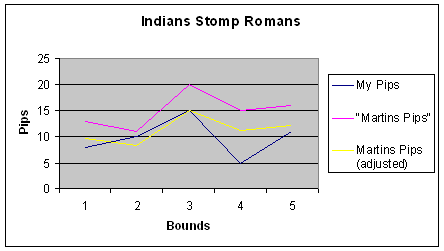
As the chart shows, this was not to be - the Indians started with enough pips to get their entire line to 200 paces from mine, and then scored a massive 5-5-5-5 in the decisive turn 3 when I was hit by 18 BdF and the best part of 9 elephants. With only one command scoring a "1" all game, and out-pipping me throughout, my plan was in tatters and my figures were soon back in the box, although I did manage to nail the CinC at the death after my LH overwhelmed the Indian cavalry on the end of the line.
Game 5 saw this list appear for the first time and lose a close 1-9 to Bruce Brown's E Byzantines - I was 2 elements off getting his army in a massive Kn/Cm vs Kn/Cv(S) lottery across the middle of the table, but the larger Byzantine commands outlasted my smaller but more numerous ones and we went down.
Clunk!
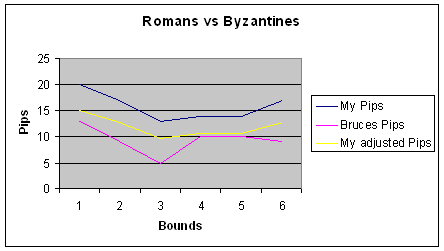
I outscored Bruce comprehensively in this game 95/56, or 71/56 adjusting for my additional command, but was unable to press the advantage as all my frontline troops were committed to combat from bound 2 onwards!
Summary:
Basically my army was rubbish, and I hadn't practiced enough to learn how to use it properly - but I also suspect that "using it properly" would have required a degree of self discipline and defensive play that I quite possibly don't possess (and a different list)!
However it was a load of laughs, if I'd have managed to nick the game from Graham it could have been very different, and playing 4 games with my 2nd string list wasn't really in my plan - I had been expecting a few knight-ey medieval armies to surprise with the Camel Corps - oh well !!! No more Patsy's for me!
The Ancient Army List Index
The Rise of Rome (280 BC to 25 BC) Mid Republican Roman ; Late Republican Roman ; Gallic ; Pyrrhic ; Later Carthaginian ; Ancient Spanish ; Later Macedonian ; Later Seleucid ; Later Ptolemaic ; Attalid Pergamene ; Numidian or early Moorish ; Pontic ; Early Armenian ; Parthian ; Later Jewish ; Illyrian ; Spartacus Slave Revolt ; Bosporan ;
Storm of Arrows - Western Europe in the Later Middle Ages (1300 AD to 1500 AD) Medieval French ; 100-yrs War English (Continental) ; 100-yrs War English (Britain) ; Later Medieval Scots ( Britain) ; Later Medieval Scots (Continental) ; Later Scots Isles & Highlands ; Medieval Welsh ; Later Anglo-Irish ; Medieval Irish ; Low Countries ; Later Medieval German ; Italian Condotta ; Swiss ; Free Company ; Medieval Burgundian ; Medieval Danish ; Medieval Swedish ; Medieval Castilian ; Medieval Crown of Aragon ; Medieval Portugese ; Later Granadine ; Navarrese ; Ordonnance French ; Wars of the Roses English ; Ordonnance Burgundian ; Santa Hermandad Nueva Castilian
Immortal Fire - The Greek, Persian & Macedonian Wars (550 BC - 146 BC)
Classical Greek ;
Early Achaemenid Persian ;
Lydian ;
Thracian ;
Syracusan ;
Early Carthaginian ;
Skythian or Saka ;
Kyrenean Greek ;
Late Dynastic Egyptian ;
Alexandrian Macedonian ;
Later Achaemenid Persian ;
Classical Indian ;
Early Successor ;
Early Sarmatian ;
Galatian ;
Hellenistic Greek ;
Graeco-Bactrian ;
Graeco-Indian ;
Indo-Greek :
Legions Triumphant - Imperial Rome (25 BC to 493 AD) Dominate Roman ; Principate Roman ; Foederate Roman ; Later Sarmatian ; Early German ; Dacian or Carpi ; Ancient British ; Caledonian ; Early Alan ; Jewish Revolt ; Sassanid Persian ; Kushan or Indo-Skythian ; Palmyran ; Early Frankish, Alamanni, Burgundi, Limigantes, Rugian, Suevi or Turcilingi ; Western Hunnic ; Early Visigothic & Early Vandal ; Early Ostrogothic, Herul, Sciri or Taifali ; Early Anglo-Saxon, Bavarian, Frisian, Old Saxon or Thuringian ; Gepid or Early Lombard ; Early Scots Irish ; Early Pictish ; Hephthalite Hunnic ;
Swords & Scimitars - The Crusades (1096 AD to 1311 AD) Early Crusader ; Later Crusader ; Fatimid Egyptian ; Georgian ; Seljuk Turk ; Cuman ; Komnenan Byzantine ; Post Latin Conquest Byzantine ; Ilkhanid Mongol ; Mamluk Egyptian ; Cilician Armenian ; Syrian States ; Khwarazmian ; Ayyubid Egyptian ; Middle Serbian ; Middle Bulgarian ; Medieval Cypriot ; Latin Greece ; Pecheneg ;
Eternal Empire - Eastern Europe and the Rise of the Ottomans (1300 AD to 1500 AD) Early Ottoman Turkish ; Later Ottoman Turkish ; Tatar ; Later Russian ; Later Serbian Empire ; Later Bulgarian ; Later Lithuanian ; Later Polish ; Later Teutonic Knights ; Catalan Company ; Middle Hungarian ; Moldavian or Wallachian ; Albanian ; Timurid, White Sheep Turcoman or Black Sheep Turcoman ; Later Hungarian ; Hussite ;
Decline & Fall - Byzantium and Islam (493 AD to 1071 AD) Early Byzantine; Maurikian Byzantine ; Thematic Byzantine ; Nikephorian Byzantine ; Later Moorish ; Later Visigothic ; African Vandal ; Italian Ostrogothic ; Early South Slav ; Lombard ; Avar ; Arab Conquest ; Early Bulgar ; Ummayad Arab ; Abbasid Arab ; Early North African Dynasties ; Khurasanian Dynasties ; Bedouin Dynasties ; Dailami Dynasties ; Pecheneg ; Ghaznavid ; Western Turkish (includes Khazar);
Wolves From The Sea - The Hairy European Dark Ages Post Roman British ; Early Welsh ; Later Scots Irish ; Merovingian Frankish ; Later Pictish ; Early Slavic ; Middle Anglo Saxon ; Astur Leonese ; Andalusian ; Early Navarrese ; Carolingian Frankish ; Viking ; Magyar ; Great Moravian ; Early Scots ; Rus ; Norse Irish ; Early Medieval French ; Early Medieval German ; Norman ; Early Polish ; Anglo Danish ;
Swifter Than Eagles - The Biblical Book Nubian ; Early Libyan ; Later Sumerian or Akkadian ; Early Nomad Allies ; Old or Middle Kingdom Egyptian ; Hyksos ; Mitanni ; Syro-Canaanite ; New Kingdom Egyptian ; Later Minoan or Early Mycenaean ; Hittite Empire ; ; Middle or Early Neo-Assyrian ; Later Mycenaean or Trojan ; Sea Peoples ; Philistine ; Phoenician Allies ; Neo-Hittite And Aramaean ; Later Hebrew ; Mannaean Allies ; Libyan Egyptian ; Urartian ; Median ; Neo-Elamite ; Proto-Arab Allies ; Cimmerian or Early Skythian ; Neo-Assyrian Empire ; Phrygian Allies ; Kushite Egyptian ; Neo-Babylonian Empire ;
Oaf of Fealty - Early Medieval Europe Feudal Catalan and Early Crown Of Aragon ; Early Hungarian ; Taifa Andalusian ; Feudal Navarrese and Aragonese ; Feudal Castilian Leonese or Portuguese ; Fanatic Berber ; Italo-Norman ; Feudal French ; Imperial German ; Feudal German ; Communal Italian ; Papal Italian ; Early Scots Isles And Highlands ; Feudal Scots ; Early Russian ; Feudal Polish ; Anglo-Norman ; Later Welsh ; Early Lithuanian or Samogitian ; Wendish Prussian or Estonian ; Early Medieval Frisia and Other Free Cantons ; Post-Viking Scandinavian ; Early Plantagenet English ; Later Sicilian ; Early Medieval Irish ; Early Anglo-Irish ; Early Teutonic Knights ; Mongol Invasion ; Early Granadine ; Middle Plantagenet English ;
Empires of The Dragon - China, Korea and Japan Erlitou-Shang Chinese ; Early Northern Barbarian Allies ; Early Zhou Chinese ; Yayoi Japanese ; Early Horse Nomad ; Ko Choson Korean ; Warring States To Western Han Chinese ; Qiang And Di ; Three Kingdoms Korean ; Eastern Han Chinese? ; Three Kingdoms W Jin And S Dynasties Chinese ; Kofun Nara Japanese ; Northern Dynasties Chinese ; Later Hindu North Indian ; Later Hindu South Indian ; Central Asian City States ; Western Wei To Early Tang Chinese ; ; Later Horse Nomad ; Tibetan ; Nepalese Allies ; Parhae Korean ; Late Tang To Five Dynasties Chinese ; Khmer Or Champa ; Thai Allies ; Nanzhao ; Pyu Burmese Allies ; Koryo Korean ; Early Heian Japanese ; Pagan Burmese ; Liao ; Song Chinese ; Xi Xia ; Ghurid Afghan ; Jin ; Late Heian To Muromachi Japanese ; Japanese Warrior Monk Allies ; Mongol Conquest ; Moslem Indian Sultanates ; Medieval Indonesian Or Malay ; Yuan Chinese ; Medieval Burmese ; Ming Chinese ; Yi Korean
Blood and Gold - The Americas Olmec ; Teotihuacan ; West Mexican ; Zapotec or Mixtec ; Toltec ; Chinantec ; Aztec ; Tarascan ; Tlaxcalan Confederacy ; Mayan ; Mochica ; Chanca ; Chimu ; Hatun-Colla ; Canari ; Inca ; Mapuche or Araucanian ; Amazonian Forest Tribes ; Tupi ; Chichimec ; Pueblo Culture ; Mound-Builder Culture ; South-Eastern Woodland Culture ; Timucuan ; Eastern Woodland Culture ; Plains Culture ; Pacific North-West Culture


